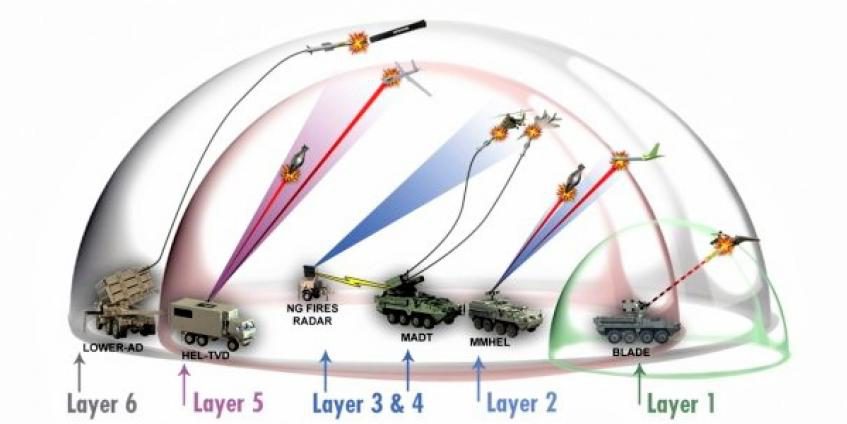In his fifth article of the series on how the U.S. Army Combat Capabilities Development Command (CCDC) is supporting the Army’s six modernization priorities, Maj. Gen. Cedric T. Wins discusses the Army’s road map to their six layers or “domes of protection” against missiles, unmanned aerial vehicles/unmanned aerial systems (UAV/UAS), and other threats [1]. The modernization strategy is designed to ensure the Army maintains overmatch against U.S. peer adversaries.
The following layers are briefly described in order of protection area/range and discussed in detail in MG Wins’s article. In the full article, MG Win also discusses leveraging partnerships with academia and industry to facilitate the modernization strategy.
- Layer 1 – Ballistic, Low-Altitude Drone Engagement (BLADE) – a tactical edge maneuvering soldier system to counter moving targets such as Group 1 to Group 5 UAV/UAS; works with the Common Remotely Operated Weapon Station (CROWS) and uses advanced fire control and precision targeting enablers to detect, track, and defeat UAS.
- Layer 2 – Multi-Mission High-Energy Laser (MMHEL) – high-energy laser system for integration onto combat platforms; operational demonstration targeted to occur in fiscal year (FY) 2021; a platoon of four Stryker vehicles with experimental MMHEL prototypes in FY 2022 to support Maneuver – Short-Range Air Defense (M-SHORAD).
- Layers 3 and 4 – Maneuver Air Defense Technology (MADT) and Next-Generation Fires Radar – enable a greater level of protection by hitting larger aircraft at increased ranges; MADT interceptor technologies will be integrated onto the Stryker as part of the M-SHORAD platform and will include systems such as chain guns, Hellfire missiles, Stinger missiles, infrared sensors, and the Next-Generation Fires radar.
- Layer 5 – High-Energy Laser Tactical Vehicle Demonstrator (HEL-TVD) – a 100-kW class laser system on a family of medium tactical vehicles (FMTV) platform; will be used to refine a path forward to more advanced solid-state fiber laser systems that can provide counter rocket, artillery, and mortar fires and protect against unmanned aerial systems.
- Layer 6 – Low-Cost Extended Range Air Defense (LOWER AD) – a missile interceptor that is smaller and less costly than systems like the Patriot but can still defeat subsonic cruise missiles and lethal unmanned aerial systems; flight testing is targeted to occur in FY 2021.


